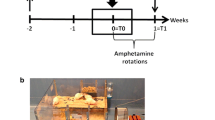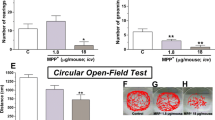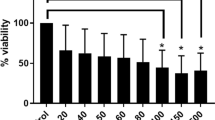Abstract
Parkinson’s disease (PD) is the second most common neurodegenerative disease in the world, being characterized by dopaminergic neurodegeneration of substantia nigra pars compacta. PD pharmacotherapy has been based on dopamine replacement in the striatum with the dopaminergic precursor 3,4-dihydroxyphenylalanine (l-DOPA) and/or with dopaminergic agonists, alongside anticholinergic drugs in order to mitigate the motor abnormalities. However, these practices neither prevent nor stop the progression of the disease. Environmental enrichment (EE) has effectively prevented several neurodegenerative processes, mainly in preclinical trials. Several studies have demonstrated that EE induces biological changes, bearing on cognitive enhancement, neuroprotection, and on the attenuation of the effects of stress, anxiety, and depression. Herein, we investigated whether EE could prevent the motor, biochemical, and molecular abnormalities in a murine model of PD induced by 1-methyl-4-phenyl-2,3-dihydropyridine (MPTP). Our results show that EE does not prevent the dopaminergic striatal depletion induced by MPTP, despite having averted the MPTP-induced hyperlocomotion. However, it was able to slow down and avoid, respectively, the 3,4-dihydroxyphenylacetic acid (DOPAC) and homovanillic acid (HVA) depletion. Analysis of dopaminergic mRNA alterations in the midbrain showed that D1R expression was increased by MPTP, while the normal expression level of this receptor was restored by EE. As for the cholinergic system, MPTP led to a decrease in the ChAT gene expression while increasing the expression of both AChE and M1R. EE attenuated and prevented—respectively—ChAT and M1R gene expression alterations triggered by MPTP in the midbrain. Overall, our data brings new evidence supporting the neuroprotective potential of EE in PD, focusing on the interaction between dopaminergic and cholinergic systems.






Similar content being viewed by others
Abbreviations
- 5-HT:
-
Serotonin
- ACh:
-
Acetylcholine
- AChE:
-
Acetylcholinesterase
- ChAT:
-
Choline acetyltransferase
- ChIs:
-
Cholinergic interneurons
- D1R:
-
Dopaminergic receptor 1
- D2R:
-
Dopaminergic receptor 2
- DA:
-
Dopamine
- DAergic:
-
Dopaminergic
- DAT:
-
Dopamine transporter
- DOPAC:
-
3,4-Dihydroxyphenylacetic acid
- EE:
-
Environmental enrichment
- EM:
-
Enriched environment MPTP
- ES:
-
Enriched environment saline
- HVA:
-
Homovanillic acid
- l-DOPA:
-
3,4-Dihydroxyphenylalanine
- M1R:
-
Muscarine receptor M1
- MAO A:
-
Monoamine oxidase A
- MAO B:
-
Monoamine oxidase B
- MPTP:
-
1-Methyl-4-phenyl-2,3-dihydropyridine
- NE:
-
Norepinephrine
- PD:
-
Parkinson’s disease
- SM:
-
Standard environment MPTP
- SNpc:
-
Substantia nigra pars compacta
- SNr:
-
Substantia nigra pars reticulata
- SS:
-
Standard environment saline
- TH:
-
Tyrosine hydroxylase
- α7NR:
-
Alpha 7 nicotinic receptor
References
Areal LB, Rodrigues LCM, Andrich F, Moraes LS, Cicilini MA, Mendonça JB, Pelição FS, Nakamura-Palacios EM, Martins-Silva C, Pires RG (2015) Behavioural, biochemical and molecular changes induced by chronic crack-cocaine inhalation in mice: the role of dopaminergic and endocannabinoid systems in the prefrontal cortex. Behav Brain Res 290:8–16
Bagga P, Chugani AN, Patel AB (2016) Neurochemistry international neuroprotective effects of caffeine in MPTP model of Parkinson’s disease: a 13 C NMR study. Neurochem Int 92:25–34
Bartels AL, Leenders KL (2009) Parkinson’s disease: the syndrome, the pathogenesis and pathophysiology. Cortex 45:915–921
Benbir G, Ozekmekçi S, Apaydin H, Delil S, Erginöz E (2006) A hospital-based study: risk factors in development of motor complications in 555 Parkinson’s patients on levodopa therapy. Clin Neurol Neurosurg 108:726–732
Bermudez MA, Schultz W (2014) Timing in reward and decision processes. Philos Trans R Soc Lond Ser B Biol Sci 369(1637):20120468
Bezard E, Dovero S, Belin D, Duconger S, Jackson-Lewis V, Przedborski S, Piazza PV, Gross CE, Jaber M (2003) Enriched environment confers resistance to 1-methyl-4-phenyl-1,2,3,6-tetrahydropyridine and cocaine: involvement of dopamine transporter and trophic factors. J Neurosci 23(35):10999–11007
Blusztajn JK, Wurtman RJ (1983) Choline and cholinergic neurons. Science 221:614–620
Bohnen NI, Müller ML, Koeppe RA, Studenski SA, Kilbourn MA, Frey KA, Albin RL (2009) History of falls in Parkinson disease is associated with reduced cholinergic activity. Neurology 73(20):1670–1676
Brandon EP, Lin W, D’Amour KA, Pizzo DP, Dominguez B, Sugiura Y, Thode S, Ko CP, Thal LJ, Gage FH, Lee KF (2003) Aberrant patterning of neuromuscular synapses in choline acetyltransferase-deficient mice. J Neurosci 23:539–549
Brandon EP, Mellott T, Pizzo DP, Coufal N, D’Amour KA, Gobeske K, Lortie M, López-Coviella I, Berse B, Thal LJ, Gage FH, Blusztajn JK (2004) Choline transporter 1 maintains cholinergic function in choline acetyltransferase haploinsufficiency. J Neurosci 24:5459–5466
Buxbaum AR, Haimovich G, Singer RH (2015) In the right place at the right time: visualizing and understanding mRNA localization. Nat Rev Mol Cell Biol 16(2):95–109
Cajigas IJ, Tushev G, Will TJ, tom Dieck S, Fuerst N, Schuman EM (2012) The local transcriptome in the synaptic neuropil revealed by deep sequencing and high-resolution imaging. Neuron 74(3):453–466
Cases O, Seif I, Grimsby J, Gaspar P, Chen K, Pournin S, Müller U, Aguet M, Babinet C, Shih JC, De Maeyer E (1995) Aggressive behavior and altered amounts of brain serotonin and norepinephrine in mice lacking MAOA. Science 268:1763–1766
Chen JJ, Swope DM (2007) Pharmacotherapy for Parkinson’s disease. Pharmacotherapy 27:161S–173S
Chia LG, Ni DR, Cheng LJ, Kuo JS, Cheng FC, Dryhurst G (1996) Effects of 1-methyl-4-phenyl-1,2,3,6-tetrahydropyridine and 5,7-dihydroxytryptamine on the locomotor activity and striatal amines in C57BL/6 mice. Neuroscience Letters 218(1):67–71
Cicchetti F, Drouin-Ouellet J, Gross RE (2009) Environmental toxins and Parkinson’s disease: what have we learned from pesticide-induced animal models? Trends Pharmacol Sci 30:475–482
Colotla VA, Flores E, Oscos A, Meneses A, Tapia R (1990) Effects of MPTP on locomotor activity in mice. Neurotoxicol Teratol 12(4):405–407
Crocker SJ, Smith PD, Jackson-Lewis V, Lamba WR, Hayley SP, Grimm E, Callaghan SM, Slack RS, Melloni E, Przedborski S, Robertson GS, Anisman H, Merali Z, Park DS (2003) Inhibition of calpains prevents neuronal and behavioral deficits in an MPTP mouse model of Parkinson’s disease. J Neurosci 23:4081–4091
Dauer W, Przedborski S (2003) Parkinson’s disease: mechanisms and models. Neuron 39:889–909
Deboer P, Abercrombie ED, Heeringa M, Westerink BH (1993) Differential effect of systemic administration of bromocriptine and L-DOPA on the release of acetylcholine from striatum of intact and 6-OHDA-treated rats. Brain Res 608:198–203
Ding S, Li L, Zhou FM (2015) Nigral dopamine loss induces a global upregulation of presynaptic dopamine D1 receptor facilitation of the striatonigral GABAergic output. J Neurophysiol 113:1697–1711
Faherty CJ, Raviie Shepherd K, Herasimtschuk A, Smeyne RJ (2005) Environmental enrichment in adulthood eliminates neuronal death in experimental parkinsonism. Brain Res Mol Brain Res 134(1):170–179
Ferguson SA, Law CD, Sarkar S (2015) Chronic MPTP treatment produces hyperactivity in male mice which is not alleviated by concurrent trehalose treatment. Behav Brain Res 292:68–78
Frisina PG, Haroutunian V, Libow LS (2009) The neuropathological basis for depression in Parkinson’s disease. Park Relat Disord 15:144–148
Gerfen CR, Miyachi S, Paletzki R, Brown P (2002) D1 dopamine receptor supersensitivity in the dopamine-depleted striatum results from a switch in the regulation of ERK1/2/MAP kinase. J Neurosci 22:5042–5054
Gerlach M, Riederer P (1996) Animal models of Parkinson’s disease: an empirical comparison with the phenomenology of the disease in man. J Neural Transm 103:987–1041
Goldberg NR, Haack AK, Meshul CK (2011) Enriched environment promotes similar neuronal and behavioral recovery in a young and aged mouse model of Parkinson’s disease. Neuroscience 172:443–452
Goldberg NR, Fields V, Pflibsen L, Salvatore MF, Meshul CK (2012) Social enrichment attenuates nigrostriatal lesioning and reverses motor impairment in a progressive 1-methyl-2-phenyl-1,2,3,6-tetrahydropyridine (MPTP) mouse model of Parkinson’s disease. Neurobiol Dis 45(3):1051–1067
Gomeza J, Zhang L, Kostenis E, Felder C, Bymaster C, Brodkin F, Shannon H, Xia B, Deng C, Wess J (1999) Enhancement of D1 dopamine receptor-mediated locomotor stimulation in M4 muscarinic acetylcholine receptor knockout mice. Proc Natl Acad Sci U S A 96:10483–10488
Hagino Y, Kasai S, Fujita M, Setogawa S, Yamaura H, Yanagihara D, Hashimoto M, Kobayashi K, Meltzer HY, Ikeda K (2015) Involvement of cholinergic system in hyperactivity in dopamine-deficient mice. Neuropsychopharmacology 40:1141–1150
Heikkila RE, Manzino L, Cabatt FS, Duvoisin RS (1984a) Protection against the dopaminergic neurotoxicity of 1-methyl-4-phenyl-1,2,3,6-tetrahydropyridine by monoamine oxidase inhibitors. Nature 311:467–469
Heikkila RE, Hess A, Duvoisin RC (1984b) Dopaminergic neurotoxicity of 1-methyl-4-phenyl-1,2,3,6-tetrahydropyridine in mice. Science 224:1451–1453
Hornykiewicz O (2001) Chemical neuroanatomy of the basal ganglia-normal and in Parkinson’s disease. J Chem Neuroanat 22:3–12
Hornykiewicz O (2006) The discovery of dopamine deficiency in the parkinsonian brain. J Neural Transm 70:9–15
Hornykiewicz O (1998) Biochemical aspects of Parkinson's disease. Neurology 51 (Issue 2, Supplement 2):S2-S9
Hristova AH, Koller WC (2000) Early Parkinson’s disease: what is the best approach to treatment. Drugs Aging 17:65–81
Jadavji NM, Kolb B, Metz GA (2006) Enriched environment improves motor function in intact and unilateral dopamine-depleted rats. Neuroscience 140:1127–1138
Khakimova GR, Kozina EA, Buneeva OA, Aksenova LN, Medvedev AE, Ugryumov MV (2015) Activity of monoamine oxidase in the nigrostriatal system at presymptomatic and early symptomatic stages of parkinsonism in mice. Bull Exp Biol an Med 159:456–458
Khan MM, Zaheer S, Thangavel R, Patel M, Kempuraj D, Zaheer A (2015) Absence of glia maturation factor protects dopaminergic neurons and improves motor behavior in mouse model of parkinsonism. Neurochem Res 40:980–990
Kish SJ, Shannak K, Hornykiewicz O (1988) Uneven pattern of dopamine loss in the striatum of patients with idiopathic Parkinson’s disease: pathophysiologic and clinical implications. N Engl J Med 318:876–880
Lee FJS, Liu F (2008) Genetic factors involved in the pathogenesis of Parkinson’s disease. Brain Res Rev 58:354–364
Lim SAO, Kang UJ, McGehee DS (2014) Striatal cholinergic interneuron regulation and circuit effects. Front Synaptic Neurosci 6:1–23
Lundblad M, Picconi B, Lindgren H, Cenci MA (2004) A model of l-DOPA-induced dyskinesia in 6-hydroxydopamine lesioned mice: relation to motor and cellular parameters of nigrostriatal function. Neurobiology of Disease 16(1):110–123
Misgeld T, Burgess RW, Lewis RM, Cunningham JM, Lichtman JW, Sanes JR (2002) Roles of neurotransmitter in synapse formation: development of neuromuscular junctions lacking choline acetyltransferase. Neuron 36:635–648
Moraes LS, Rohor BZ, Areal LB, Pereira EV, Santos AMC, Facundo VA, Santos ARS, Pires RGW, Martins-Silva C (2016) Medicinal plant Combretum leprosum mart ameliorates motor, biochemical and molecular alterations in a Parkinson’s disease model induced by MPTP. J Ethnopharmacol 185:68–76
Moriguchi S, Yabuki Y, Fukunaga K (2012) Reduced calcium/calmodulin-dependent protein kinase II activity in the hippocampus is associated with impaired cognitive function in MPTP-treated mice. J Neurochem 120:541–551
Müller MLTM, Bohnen NI (2013) Cholinergic dysfunction in Parkinson’s disease. Curr Neurol Neurosci Rep 13:1–9
Nithianantharajah J, Hannan AJ (2006) Enriched environments, experience-dependent plasticity and disorders of the nervous system. Nat Rev Neurosci 7:697–709
Pang TYC, Hannan AJ (2013) Enhancement of cognitive function in models of brain disease through environmental enrichment and physical activity. Neuropharmacology 64:515–528
Perry JC, Da Cunha C, Anselmo-Franci J, Andreatini R, Miyoshi E, Tufik S, Vital MABF (2004) Behavioral and neurochemical effects of phosphatidylserine in MPTP lesion of the substantia nigra of rats. Eur J Pharmacol 484:225–233
Prema A, Janakiraman U, Manivasagam T, Thenmozhi AJ (2015) Neuroprotective effect of lycopene against MPTP induced experimental Parkinson’s disease in mice. Neurosci Lett 599:12–19
Rajput AH (2001) Levodopa prolongs life expectancy and is non-toxic to substantia nigra. Parkinsonism Relat Disord 8:95–100
Reksidler AB, Lima MMS, Zanata SM, Machado HB, Da Cunha C, Andreatini R, Tufik S, Vital MABF (2007) The COX-2 inhibitor parecoxib produces neuroprotective effects in MPTP-lesioned rats. Eur J Pharmacol 560:163–175
Rosenzweig MR, Bennett EL, Hebert M, Morimoto H (1978) Social grouping cannot account for cerebral effects of enriched environments. Brain Res 153(3):563–576
Sale A, Berardi N, Maffei L (2009) Enrich the environment to empower the brain. Trends Neurosci 32:233–239
Schapira AHV, Bezard E, Brotchie J, Calon F, Collingridge GL, Ferger B, Hengerer B, Hirsch E, Jenner P, Le Novère N, Obeso JA, Schwarzschild MA, Spampinato U, Davidai G (2006) Novel pharmacological targets for the treatment of Parkinson’s disease. Nat Rev Drug Discov 5:845–854
Sconce MD, Churchill MJ, Greene RE, Meshul CK (2015) Intervention with exercise restores motor deficits but not nigrostriatal loss in a progressive MPTP mouse model of Parkinson’s disease. Neuroscience 299:156–174
Shih JC (1991) Molecular basis of human MAO A and B. Neuropsychopharmacology 4:1–7
Smeyne RJ, Jackson-Lewis V (2005) The MPTP model of Parkinson’s disease. Mol Brain Res 134:57–66
Solinas M, Thiriet N, Chauvet C, Jaber M (2010) Prevention and treatment of drug addiction by environmental enrichment. Prog Neurobiol 92:572–592
Straub C, Tritsch NX, Hagan NA, Gu C, Sabatini BL (2014) Multiphasic modulation of cholinergic interneurons by nigrostriatal afferents. J Neurosci 34:8557–8569
Tanila H, Björklund M, Riekkinen P (1998) Cognitive changes in mice following moderate MPTP exposure. Brain Res Bull 45:577–582
Tsukada H, Harada N, Nishiyama S, Ohba N, Kakiuchi T (2000) Cholinergic neuronal modulation alters dopamine D2 receptor availability in vivo by regulation receptor affinity induced by facilitated synaptic dopamine turnover: positron emission tomography studies with microdialysis in the conscious monkey brain. J Neurosci 20:7067–7073
Xiang Z, Thompson AD, Jones CK, Lindsley CW, Conn PJ (2012) Roles of the M1 muscarinic acetylcholine receptor subtype in the regulation of basal ganglia function and implications for the treatment of Parkinson’s disease. J Pharmacol Exp Ther 340:595–603
Xiao C, Cho JR, Zhou C, Treweek JB, Chan K, McKinney SL, Yang B, Gradinaru V (2016) Cholinergic mesopontine signals govern locomotion and reward through dissociable midbrain pathways. Neuron 90(2):333–347
Yabuki Y, Ohizumi Y, Yokosuka A, Mimaki Y, Fukunaga K (2014) Nobiletin treatment improves motor and cognitive deficits seen in MPTP-induced Parkinson model mice. Neuroscience 259:126–141
Zapata A, Chefer VI, Shippenberg TS, Denoroy L (2009) Detection and quantification of neurotransmitters in dialysates. Curr Protoc Neurosci 48(7.4):1–30
Acknowledgments
The authors thank the Health Sciences Center facility Laboratório de Análises Biomoleculares (LABIOM). This work was supported by Conselho Nacional de Ciencia e Tecnologia (grant 479243/2013-1), Fundação de Amparo a Pesquisa do Estado do Espirito Santo (grant 0603/2015) and Coordenação de Aperfeiçoamento de Pessoal de Nível Superior (CAPES).
Author Contributions
RGWP and CMS were responsible for the study concept and all experimental designs. WFH contributed with data acquisition and analysis and drafted the manuscript. ALH and LAAM provided essential critical analysis of the manuscript. LSM was responsible for dopamine and metabolites assessment. TAAF and TESA were responsible for qPCR assays.
Author information
Authors and Affiliations
Corresponding author
Ethics declarations
Conflict of Interest
No conflict of interest is reported.
Rights and permissions
About this article
Cite this article
Hilario, W.F., Herlinger, A.L., Areal, L.B. et al. Cholinergic and Dopaminergic Alterations in Nigrostriatal Neurons Are Involved in Environmental Enrichment Motor Protection in a Mouse Model of Parkinson’s Disease. J Mol Neurosci 60, 453–464 (2016). https://doi.org/10.1007/s12031-016-0831-7
Received:
Accepted:
Published:
Issue Date:
DOI: https://doi.org/10.1007/s12031-016-0831-7




